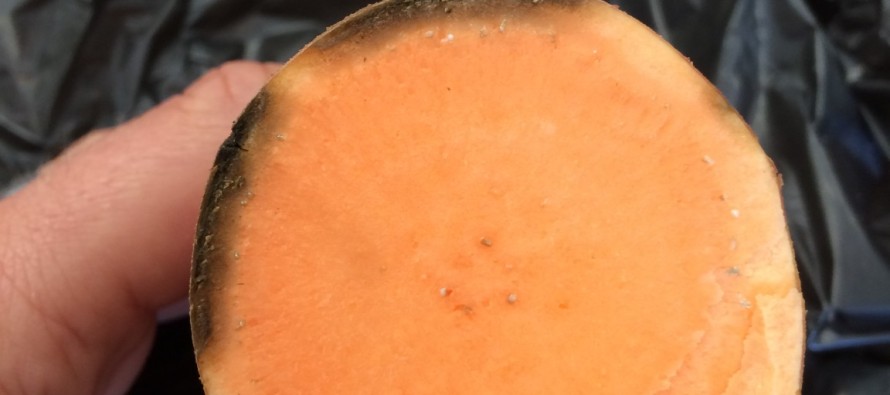Black Rot in Sweetpotato- A Fact Sheet

Related Articles
- Evaluation of Peanut Prescription Rx Program in Mississippi 0
- 2010 Row Crop Short Course Video Links 0
- Identifying Wheat Growth Stages using the Feekes Scale 4
Latest Tweets
Black rot is on the minds of many sweetpotato producers in the United States. The fungal disease was reported in North Carolina in 2015, and there have been at least three diagnosed incidence of black rot in Mississippi since last fall.
Causal organism: The disease is caused by the fungus Ceratocystis fimbriata.
About the disease: Black rot can occur in any stage of the sweetpotato production cycle. Lesions on storage roots typically occur at lenticels, wounds, or where lateral roots attach to the storage root. Lesions are firm, black, and dry and often only go as far as the vascular ring, but can penetrate deeper into the storage root if accompanied by a secondary pathogen, such as Fusarium. The pathogen produces a fruity odor which may be detected on infected roots. When infected “seed” are bedded, the pathogen can spread to the developing slip forming dark black, sunken cankers. The pathogen can infect numerous woody and herbaceous plants. However, the strain that infects sweetpotato appears to infect only sweetpotato and other plant species in the morningglory family (Convolvulaceae).
Management: Management for black rot is similar in many ways to the integrated pest management approach recommended for other soil-borne sweetpotato diseases.
-Use only disease-free seed roots in plant beds. If you suspect your seed have black rot, do not bed them.
-Apply a fungicide to “seed” roots at bedding. Thiabendazole, the active ingredient in Mertect, reportedly offers good control. Ensure that the fungicide is applied in a sufficient volume of water to achieve thorough coverage of “seed” root surfaces.
-Avoid planting sweetpotatoes in fields with a history of black rot. The pathogen is believed to survive at least two years in affected fields.
-Control morningglories in rotation years. The strain of C. fibriata that infects sweetpotatoes, can also infect morningglories, close relatives to sweetpotato.
-Cut slips at least 1” above the soil surface. This limits the amount of inoculum moved to the production field and helps to avoid knife contact with potentially infected soil.
-Do not harvest, wash, or pack infected roots. Handling infected roots encourages the spread of the pathogen onto harvesting bins and packing lines.
-Cure sweetpotatoes immediately after harvesting in an environment with 85-90 F, 85-90% relative humidity, and sufficient airflow for 5 to 10 days. Doing so helps to heal wounds and abrasions acquired during the harvesting process.
-Pressure wash equipment to remove all visible debris and treat with an approved fungicide.
Mississippi growers who suspect they have black rot can contact Stephen Meyers at stephen.meyers@msstate.edu or 662-489-4621. Or submit samples directly to the Mississippi State University Plant Diseases and Nematode Diagnostic Lab (http://msucares.com/lab/).
Literature Cited:
Clark, CA, DM Ferrin, TP Smith, and GJ Holmes, eds. 2013. Compendium of Sweetpotato Diseases, Pests, and Disorders- 2nd Edition. St. Paul, MN: American Phytopathological Society. Pp. 29-33.






Let me tell You a sad story ! There are no comments yet, but You can be first one to comment this article.
Write a comment